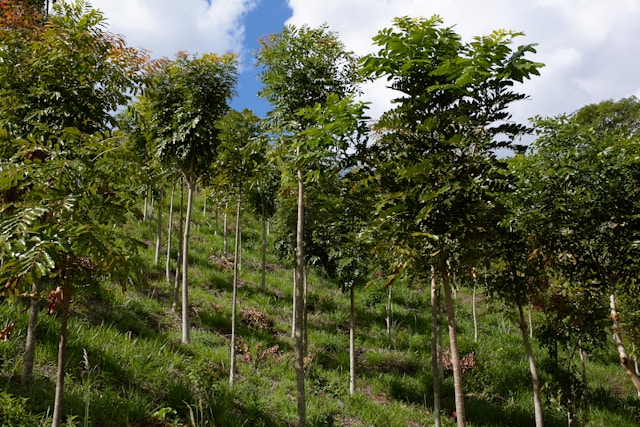How does urban reforestation improve air quality and reduce the urban heat island effect?

Urban reforestation has emerged as a promising solution to the growing concerns of air quality and the urban heat island effect in our cities. A simple yet effective approach, reforestation involves the restoration and planting of trees in urban areas. With an increasing number of cities around the globe acknowledging their role in mitigating the effects of climate change, urban reforestation initiatives are on the rise.
The Power of Trees in Urban Areas
Trees are nature’s very own air purifiers. A single tree can absorb as much as 48 pounds of carbon dioxide per year, and can sequester one ton of carbon dioxide by the time it reaches 40 years old. The role of trees in improving air quality in cities goes beyond carbon absorption, as they can also filter out harmful pollutants, including nitrogen oxides, ammonia, sulfur dioxide, and particulates.
Also read : What role does eco-friendly transportation play in reducing greenhouse gas emissions?
Moreover, trees provide shade, which reduces the need for air conditioning in nearby buildings and therefore reduces energy consumption. They also release water vapour through a process called transpiration, which can help cool the air.
Given these benefits, the planting of trees becomes a crucial strategy in enhancing air quality in urban areas. City planners have the opportunity to strategically place trees to maximise their potential, such as in areas with high traffic or near industrial zones where air pollution is typically higher.
Also read : The Benefits of Professional Cat Boarding Over Pet Sitting
The Urban Heat Island Effect and Its Mitigation through Urban Reforestation
The urban heat island effect refers to the phenomenon where urban areas experience higher temperatures than their rural surroundings due to human activities and the prevalence of concrete and asphalt, which absorb and retain heat. This phenomenon exacerbates the effects of heatwaves, posing a risk to public health, especially among the elderly and those with underlying health conditions.
Trees and green spaces play a crucial role in mitigating the urban heat island effect. They shade buildings and streets, reducing the amount of heat absorbed. Their leaves also release water vapour into the air – a process known as transpiration, which cools the surrounding air.
The integration of urban forests and green spaces in city planning is therefore critical in reducing urban heat islands. Cities around the world are recognising this and are investing in urban reforestation initiatives to plant more trees and restore green spaces.
The Impacts of Climate Change on Urban Areas and the Role of Reforestation
Climate change poses a significant threat to cities, with an increased risk of extreme weather events such as heatwaves, storms, and heavy rainfall. These events can lead to health problems, damage infrastructure, and disrupt city services.
Urban reforestation offers a natural solution to these problems. By absorbing carbon dioxide, a major greenhouse gas, trees help mitigate climate change. Furthermore, their shade and the cool air they release through transpiration help reduce the heat in urban areas, making them more liveable and resilient to heatwaves.
Urban reforestation also contributes to climate change adaptation by reducing the risk of flooding. Trees and green spaces act as natural sponges, absorbing rainwater and reducing surface runoff, which can help prevent flooding during heavy rainfall events.
Urban Reforestation: A Strategy for Sustainable Cities
Cities are at the forefront of the climate crisis, and hence, they also have the power to drive necessary change. Urban reforestation is one such strategy that cities can employ to become more sustainable and resilient to climate change.
By increasing the number of trees and green areas, cities can improve air quality, reduce temperatures, and create healthier, more enjoyable environments for their residents. Moreover, urban forests serve as habitats for wildlife, contributing to urban biodiversity.
Additionally, urban reforestation can bring social benefits. Green areas offer spaces for recreation and relaxation, contributing to the mental health and well-being of urban residents. They also provide opportunities for community involvement, as residents can participate in tree planting and care activities.
While urban reforestation is not the only solution to the complex challenges of climate change, air pollution, and urban heat islands, it is certainly a significant part of the solution. With thoughtful planning and implementation, it can help cities become more sustainable, resilient, and liveable.
As the urgency to address climate change intensifies, let urban reforestation be a call to action for all cities. It is time to reimagine our concrete jungles as thriving urban forests that not only provide aesthetic value but also play a critical role in our fight against climate change. Let us remember that the simple act of planting a tree can help create a healthier, cooler, and more sustainable city.
Integrating Urban Reforestation with Traditional Infrastructure
Advancements in technology and human ingenuity have led to the development of our modern cities, densely packed with concrete structures, roads, and parking lots. But with it comes the challenge of urban heat islands and poor air quality. Urban forestry plays a key role in countering these issues.
In addition to outright tree planting, integrating green infrastructure into traditional infrastructure can maximize urban forests’ benefits. This can take the form of implementing green roofs or walls, integrating tree-lined streets, and creating green belts around or within urban areas. These additions not only improve air quality and reduce urban heat, but also add aesthetic appeal to the cityscape.
Green roofs and walls can reduce the need for air conditioning, not only shading the building but also absorbing heat and releasing it back into the atmosphere slowly at night, reducing temperature fluctuations. They also improve stormwater management by absorbing rainwater, which otherwise would contribute to urban flooding.
Tree-lined streets, apart from providing shade, can act as a buffer against air pollution from traffic. Studies have shown that trees can reduce the concentration of pollutants on busy streets by up to 60%.
Green belts or urban green spaces provide a sanctuary for urban dwellers, offering recreational and relaxation spaces that contribute to residents’ mental health and well-being. They also serve as wildlife habitats, promoting urban biodiversity.
Conclusion: The Future of Urban Reforestation
The fight against climate change, poor air quality, and the urban heat island effect will require a multi-faceted approach, and urban reforestation is a significant part of this. Cities around the world should recognize the potential of tree planting and the integration of green spaces into their urban planning.
While the task may seem daunting, the benefits that come with urban reforestation are undeniable. From acting as natural air purifiers and coolants, contributing to stormwater management, to providing habitats for wildlife and recreational spaces for humans – urban forests offer a wealth of advantages.
In conclusion, we must remember that the journey to sustainable cities is not a one-time event, but a continuous process. It is about integrating the old with the new, merging the concrete with the green, and balancing urbanization with nature. As we move forward, let urban reforestation be our guiding principle in urban planning. It is now more critical than ever that we envision and create urban areas that are healthy, resilient, and sustainable.
So, let’s roll up our sleeves and get planting. After all, the best time to plant a tree was 20 years ago, and the second-best time is now.
